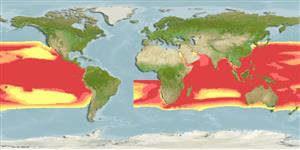>
Beloniformes (Needle fishes) >
Hemiramphidae (Halfbeaks)
Etymology: Euleptorhamphus: Greek, eu = good + Greek, leptos = thin + greek, rhamphos = bill, peak (Ref. 45335).
Environment: milieu / climate zone / depth range / distribution range
Écologie
marin; océanodrome (Ref. 51243); profondeur 0 - 1 m (Ref. 58302). Subtropical
Indo-Pacific: Red Sea and East Africa to Hawaii (Ref. 583) and Tonga, north to southern Japan, south to Australia, New Zealand and Kermadec Islands (Ref. 8879). Eastern Pacific: southern California, USA to Ecuador, including the Galapagos Islands (Ref. 2850).
Length at first maturity / Taille / Poids / Âge
Maturity: Lm ?, range 25 - ? cm
Max length : 53.0 cm TL mâle / non sexé; (Ref. 55763); common length : 30.0 cm SL mâle / non sexé; (Ref. 9306)
Épines dorsales (Total): 0; Rayons mous dorsaux (Total): 21-25; Épines anales 0; Rayons mous anaux: 20 - 25; Vertèbres: 70 - 75. Body very elongate; lower jaw very prolonged; upper jaw short, triangular, and scaly; teeth present on vomer and tongue; dorsal fin with 22 to 25 rays; anal fin with 22 to 24 rays; pectoral fins long, with 8 or 9 rays; back iridescent blue green; belly silvery (Ref. 55763). Fins unpigmented (Ref. 4164).
Usually oceanic but enters large open bays (Ref. 2850). Found around islands (Ref. 9306). Capable of jumping out of the water and gliding above the surface (Ref. 9306).
Life cycle and mating behavior
Maturité | Reproduction | Frai | Œufs | Fécondité | Larves
Collette, B.B. and J. Su, 1986. The halfbeaks (Pisces, Beloniformes, Hemiramphidae) of the Far East. Proc. Acad. Nat. Sci. Philadelphia 138(1):250-301. (Ref. 10943)
Statut dans la liste rouge de l'IUCN (Ref. 130435)
Menace pour l'homme
Harmless
Utilisations par l'homme
Pêcheries: intérêt commercial mineur
Plus d'informations
RéférencesAquacultureProfil d'aquacultureSouchesGénétiqueElectrophoresesHéritabilitéPathologiesTraitementNutrientsMass conversion
Outils
Articles particuliers
Télécharger en XML
Sources Internet
Estimates based on models
Preferred temperature (Ref.
123201): 20.2 - 29.2, mean 26.9 °C (based on 43417 cells).
Phylogenetic diversity index (Ref.
82804): PD
50 = 0.7500 [Uniqueness, from 0.5 = low to 2.0 = high].
Bayesian length-weight: a=0.00102 (0.00046 - 0.00225), b=3.06 (2.88 - 3.24), in cm total length, based on all LWR estimates for this body shape (Ref.
93245).
Niveau trophique (Ref.
69278): 3.4 ±0.45 se; based on food items.
Résilience (Ref.
120179): Haut, temps minimum de doublement de population inférieur à 15 mois (Preliminary K or Fecundity.).
Fishing Vulnerability (Ref.
59153): Moderate vulnerability (41 of 100).
Nutrients (Ref.
124155): Calcium = 167 [64, 396] mg/100g; Iron = 1.55 [0.67, 3.54] mg/100g; Protein = 18.2 [15.7, 20.6] %; Omega3 = 0.224 [0.091, 0.652] g/100g; Selenium = 10.7 [4.1, 29.3] μg/100g; VitaminA = 21.4 [5.4, 94.5] μg/100g; Zinc = 0.862 [0.517, 1.441] mg/100g (wet weight);
